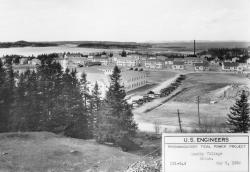
President Roosevelt, Eastport, 1936
National Archives at Boston
Text by Candace Kanes
Images from Maine Historical Society, Lubec Historical Society and National Archives Northeast Region
Tide mills – submerged water wheels that run machinery – have been used in Maine at least since the 18th century.
But tide mills are small-scale projects. For nearly 90 years, the idea of harnessing ocean tides on a larger scale, to generate electricity, has been debated in Maine. The most prominent – and often controversial – plan has been the Passamaquoddy Tidal Power Project.
One appeal of using ocean tides, rather than river tides, is that they occur so regularly, unaffected by droughts or other such disturbances.
Passamaquoddy Bay was an obvious choice for the project because more than 70 billion cubic feet of water in tides flowed in and out of the bay twice each day.
In 1920, Dexter P. Cooper, a young engineer who had worked with hydroelectric power, came up with a tidal power plan for Washington County.

Temporary buildings plot plan, Passamaquoddy Tidal project, 1935
Maine Historical Society
His initial plan was international, damming both Cobscook and Passamaquoddy bays to create the pools necessary to feed turbines. He had a powerful supporter, Franklin D. Roosevelt, who owned a home on nearby Campobello Island.
Roosevelt endorsed the idea in a speech he gave in 1920 in Eastport while he was a candidate for vice president.
Through the 1920s, Cooper worked on the project, will help from Roosevelt.
They went to big power companies like General Electric, Westinghouse, and Alcoa, looking for money for initial work on the project. They hoped to have $1 million in private funds for construction.
New Brunswick had agreed to plans for the huge project, passing an act to stipulate that the work had to be completed by 1932. The Federal Power Commission in the U.S. also had authorized development work.
The stock market crash of 1929 scuttled private investment and public support. In addition, Canadian fishermen worried about hurting fish stocks and railroads about damage to the tourist industry in New Brunswick.

Quoddy Tidal Power Project dam, Lubec, ca. 1937
Lubec Historical Society
When FDR became president and initiated the New Deal, he and Cooper and others pushed for federal investment in the project, arguing that it would provide much needed economic recovery to Washington County.
Critics said there was no market for power generated in Eastport, a fact that would make the project too expensive. A Federal Power Commission report determined that tidal power would be more expensive than steam-generated power.
Maine appointed a five-person Quoddy Hydro-Electric Commission in 1934 to further study the idea. The group reported in January 1935 that the project could proceed only if federal funds were available and that it would be appropriate for Maine to get relief funds to be used for tidal power.
Other study groups also stressed the benefits of Quoddy Tidal Power.
In 1935, the Passamaquoddy Bay Tidal Power Project received $7 million from the Public Works Administration, funds Roosevelt could allocate without Congressional approval. The money was spent on two dams across Cobscook Bay, a two-way navigation lock, a gate structure, a main generating station, and permanent and temporary housing at a nearby site named Quoddy Village.
The project faced a variety of political challenges and opposition from various sources in Maine and in Washington.

Quoddy Village, 1936
National Archives at Boston
Among the opponents were Central Maine Power Co., Bangor Hydro-Electric and other power generating firms in Maine that feared the federally funded project would generate electricity at a lower cost than they could, thereby hurting their businesses.
Republican Governor Ralph Owen Brewster agreed to support the project if he was guaranteed some Democratic support and credit, something Roosevelt-loyal Democrats did not want to do.
In Congress, Southern opposition defeated funded for the project.
Quoddy Tidal Power was not refunded. Work was stopped in August 1936.
The National Youth Administration moved into some of the buildings, providing a job-training center for young men. During World War II, the Seabees used the facilities, which they renamed Camp Lee-Stephenson.
Cancellation of the project left Eastport in a difficult situation because the town had invested in efforts to attract industry to the area. Eastport declared bankruptcy in 1937.
Discussion of reviving the Passamaquoddy Tidal Power Project has surfaced every few years, with studies undertaken and debates renewed. Each time, most people agree that the engineering plan is sound: the project could be built and it would work. Other considerations, however, have kept the project from being resumed.

